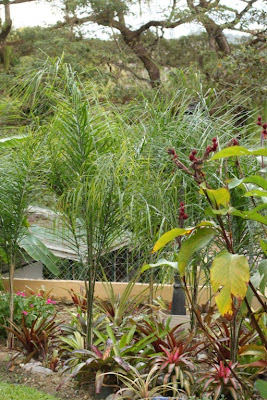My Jade Vine is flowering.

The colour is striking. My pictures do not do the flower justice, the colour is truly jade, a blue grey that I have not seen very often in nature. There is a translucence that it difficult to reproduce with the camera. It is an extraordinary hue that is completely different to all the other greens in the garden.
Strongylodon macrobotrys is the jade vine's show name. Each display is at least 18 inches long and, from what I have seen, the inflorescence lasts for approximately a week.
Each day, the flower sheds individual blooms and the ground below is littered with magical offerings that are striking in both colour and shape.
I feel very fortunate to be back in the garden. Everything has started to come into flower with the changing of the seasons. Even the cats are coming out to enjoy the scenery!






This is the shape that my new garden is taking.
But with my jade vine in bloom, my starburst clerodendron jumping off the branches My coffee trees are in flower AND I'm happy to report that I saw the first bloom of my Amherstia nobilis. It's still too early to photograph but it should be ready in a few days.
The chutney garden is back on its way.
Monday, 21 February 2011
Jade vines and Starbursts
Posted by
My Chutney Garden
at
21:07
15
comments
![]()
Labels: Clerodendron Quadriloculare Starburst, Jade Vine, New Garden, Strongylodon macrobotrys
Friday, 14 January 2011
Monkey Pots
A few Saturdays before Christmas, my friend Jeannine and I came across a small crop of "monkey pots" for sale at the side of the road. Locally known as Trinidad Brazil nut, they are in fact related to the conventional Brazil nut as they all belong to the lecythis family (Lecythidaceae) which also includes the cannonball tree (Couroupita guianensis). The pod-like capsule is heavy and solid rather like a custom made pot and it has a detachable cover which pops off when the nuts are ready. In our case we had to give it a little help and gently prised it open after about a week.
Locally known as Trinidad Brazil nut, they are in fact related to the conventional Brazil nut as they all belong to the lecythis family (Lecythidaceae) which also includes the cannonball tree (Couroupita guianensis). The pod-like capsule is heavy and solid rather like a custom made pot and it has a detachable cover which pops off when the nuts are ready. In our case we had to give it a little help and gently prised it open after about a week.  Inside the large "pot" are a series of nuts that line the sides of the pod. Each nut is nestled in place, stacked companionably against its neighbour.
Inside the large "pot" are a series of nuts that line the sides of the pod. Each nut is nestled in place, stacked companionably against its neighbour.  Every nut is attached to an fatty appendage that is likely to provide sustenance once the seed has germinated.
Every nut is attached to an fatty appendage that is likely to provide sustenance once the seed has germinated. Apparently monkeys are very fond of this nut and are known to reach in and remove the nuts which are similar to Brazil nuts. Hence the name "monkey pot". It is also known as paradise nut.
Apparently monkeys are very fond of this nut and are known to reach in and remove the nuts which are similar to Brazil nuts. Hence the name "monkey pot". It is also known as paradise nut.
When a nut was peeled, this is what it looked like. We all tasted it, assuming that if the monkeys ate it without harm, we should be safe. It was quite bland and oily and not as "nutty" and crisp as the conventional Brazil nut. I'm not sure that I would eat it again because after running a search through Google, there seemed to be some data showing the potential for selenium poisoning. Hmmm. We are alive to tell the tale but I would not recommend randomly eating this nut without further research. But it is a fascinating pod to see. The way the nuts are packaged in this pod (complete with lid) is wonderful. I would really like to see the forest tree that grows these pods. I can only imagine that it would have to be enormous to support the weight of its extraordinary crop.
Posted by
My Chutney Garden
at
23:51
7
comments
![]()
Labels: lecythis family, monkey pods
Winter
I was lucky to be in Cambridge MA for the big winter storm that swept through Boston on Wednesday. The storm was dramatic and beautiful. It is remarkable to see a landscape transformed so completely. I am just here for a week so I feel very fortunate to have witnessed a true winterscape. Coming from the tropics, it's wonderful to see nature in action in such a powerful way.

Posted by
My Chutney Garden
at
09:11
7
comments
![]()
Labels: Winter in Cambridge.








